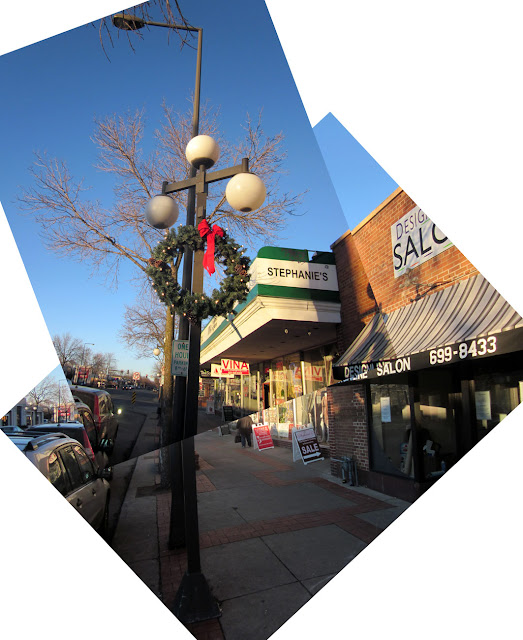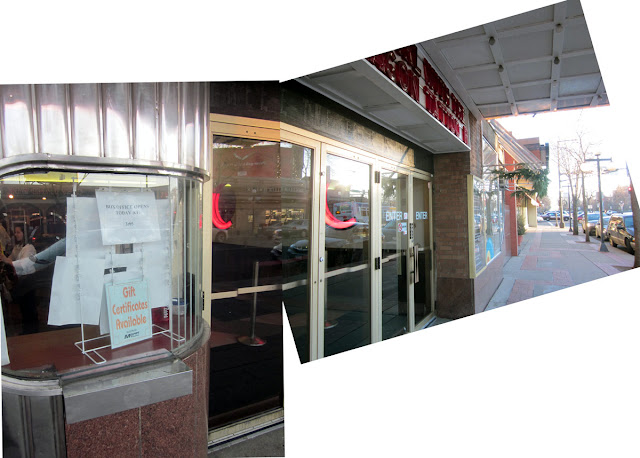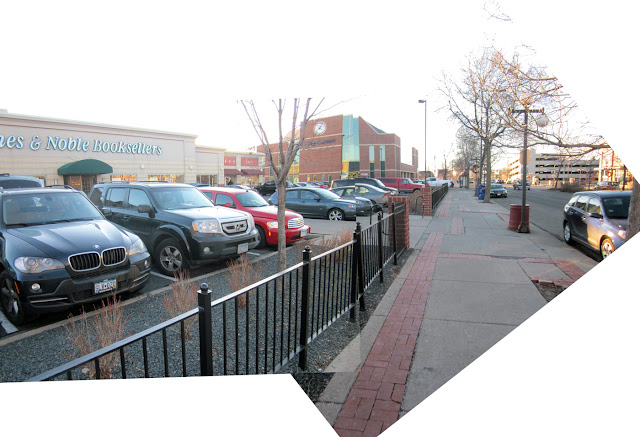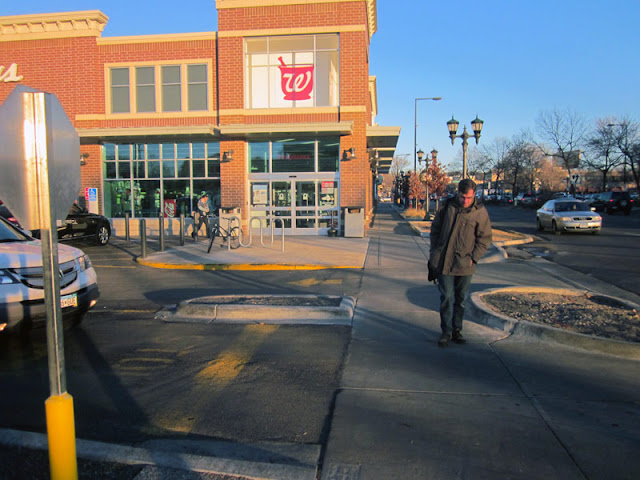 |
| [Nice bricks are all over the sidewalks.] |
Oh Highland Park, the playground of my imagination, the paddle ball of my soul. If only I could quantify the amount of time I spend straining to excavate the mind of the Highland Parker, I could write a hell of a lot off my taxes.
Highland Park is a beacon of civilization, lifting itself aloft over Saint Paul to symbolize the dreams we share when we open our garages, the look in the eyes of lonely souls everywhere that, from time to time, imagine themselves moving to the city.
“I could live in Highland Park,” you think to yourself while sitting in your robot home, and you gently raise your eyes to stare just past the track lighting and conjure a world filled with umbrella’d strolls and dog parks and fine bread and interesting stationery.
It seems like a nice place, different somehow from the dark parts of the city, those places burdened by uncomforts of rubbed shoulders or mysterious immigrants or the elaborate illegible codes of the wealthy. Next to all that, Highland Park beckons to you “normal”, a place where they accept your kind without asking too much from you.
 |
| [The old Highland theater, built in 1939.] |
 |
| [One of the finest shop windows in the Twin Cities.] |
 |
| [A sidewalk of the old school.] |
In a funny way, Highland Park symbolizes the 50s. Imagine the US in the 50s; highland park is that place. The older places in “the village” like
Cecil’s, or
the Highland Grill are some of the warmest most delightful destinations in the Twin Cities. The corner of Cleveland and Ford Parkway has its feet deep within our American imagination, the era when big cars and new appliances went hand in hand with “neighborhood” and kids on Schwinns with streamers and schools made from bricks and various Catholic traditions. It’s an era that’s since faded away to white, so hard to see against the clouds.
 |
| [What Highland Park looked like in 1945. Note the absence of houses, presence of empty green fields.] |
 |
| [Well ornamented lamppost surrounded by cars.] |
The reason is simple. Highland Park is a child of the 50s. It’s the one part of Saint Paul that somehow didn’t get built before the war. When V-J day finally came and the US attention turned to consumption and brand new homes, Highland Park lay empty along the river just at the end of town, the perfect place for progress to progress. urban suburbia, in a sense, highland park quickly filled with the finest sensibly sized homes back when homes really were sensibly sized, and its patterns are different somehow from the rest of town that bore the roots of depression and war and a million small stories.
It’s a place built just when the automobile became normal, but just before its demands and exhausts got out of hand. So in a way, the neighborhood might be the perfect hybrid, the delicate see-saw balance of cars and the city. Or so the story goes...
The only question is, Can it be done? If I know one thing, it's that you have to be suspicious of any place that calls itself “
the village.” Can you build a walking neighborhood city without removing the cars? What kind of place do you find yourself in if you try? This was the question I assigned myself as I traveled the streets I knew so well from
stories and lore.
Walking around Ford and Cleveland, testing the story with my feet, the first thing you notice is the line between the old and the new.
The Highland Theater juts up with its name in lights, and is obviously a history book. It's designed for walking, with the ticket window planted square on the sidewalk under the marquee. (Though nobody uses it any more.) If the theater had been built a bit later, it’d be surrounded by parking, placed out at arms length and it’d have more of everything, stimulation-wise flashing in your face. It’s the old part of the corner, and the shops alongside it on the North-East part of the neighborhood tell similar tales, with their brickwork and details that reward meandering.
 |
| [The old walk-up window of the Highland Theater.] |
 |
| [The Barnes & Noble has one of the more pedestrian friendly parking moats you'll find.] |
 |
| [The strip mall on the corner. The parking lot moat here has doubled in size.] |
 |
| [The fake second story Walgreen's, a brand new addition to Highland village.] |
 |
| [Jewelry, billboards, and cars.] |
Then you get to the rest of the corner, which came later. Here things are designed differently. The main thing you see is parking. There are
curb cuts galore, as just about every business is fronted by a strip mall swath of spots. Walking to most doors involves wading through this field of steel, dotted by the occasional elaborate islands of streetscape, festooned with native grasses or concrete planters trying their damnedest to botanize the asphalt. Highland Park tries so hard! It is desperate to have its cake and eat it, to create a place
where you can walk and park at the same time, somehow, oxymoronic.
And this goes on down the bluff to the river you find where the
old automobile plant, which is where all the cars came from in the first place, and as you descend the hill the parking lots grow larger until you’re faced with the giant Lund’s ocean and the groceries can only wave like mermaids riding seaward out of reach of paving stones.
And the sidewalks run through this hybrid situation as best they can, crisscrossed with decorated red pavers that become impossibly slippery when wet, and each sidewalk seems to have more ornamented fences than a gay smuggling ring.
What can you expect, I suppose, from a neighborhood that grew up in the 50s next to an automobile factory? They tried as hard as they could to make a walking / driving utopia, and it’d be difficult to find a better one.
Nobody quite seems satisfied though, and if you go to any Highland Park community meeting and bring up the subject of parking,
I hope you got comfortable first. The pedestrians are similarly slighted, at least in the parts of “the village” that aren’t by the theater.
Highland Park is one of those 2-in-1 appliances, like a combination can opener / turkey baster, or the
Hamilton Beach 22708 Toaster and Mini Oven. Technically it can do everything, but it doesn’t do either of them very well or very easily. It’s neither city or suburb, doesn’t have great walking or convenient driving. But it suffers to suffice for both. Love it or hate it, I suppose. Or both. Or neither.
 |
| [The parking lot in front of the Lunds strip mall is oceanic.] |
 |
| [This would be a nice sidewalk, if there were any buildings fronting it.] |
 |
| [A four-lane curb cut.] |
 |
| [A parking garage building.] |
 |
| [A man walks through the brand new curb cut sidewalk, hoping not to be run over.] |
















5 comments:
This is really good. I'm going to share this. - Nate
One of the parts of St Paul that didn't get built before the war - along with large sections of the far east side (pretty much everything east of White Bear I think).
Thanks Bill for elucidating our hopes and frustrations.
I've noticed an interesting self-delusion in the people I know who live in Highland Park.
When you ask them about their neighborhood they will always talk about how nice it is to walk on the sidewalks recalling the area by the theater, Cecils, the 'old' Highland.
And when I point out the moat of Lunds or how likely you are to be mowed down by cars between 3pm-7pm weekedays walking around they stare in disbelief. Not in their neighborhood! It's so quiet and serene. Theres, cars?
Side walk of the week can be enjoyed when there are less parking hassles around and a proper organization is shown with the remarkable Manchester Parking
People can leave their cars at a particular parking spot and take a round of the town. Thanks for sharing this nice article.
airport parking gatwick
Post a Comment